Meet Our Trees
Explore the catalog of tree species at Rowan University Campus Arboretum on the Glassboro campus. Each tree was researched by students, for students and the public, including information about native people, questions to inspire future research, and additional recommended resources. We hope you will learn more about the unique species that share our community!
Did you know? Our campus has:
-
- Over 2,000 individual trees
- Approximately 100 different tree species on campus
- 10 Oak species, 8 Maple species, and 7 Pine species
- Numerous trees that predate the Rowan University campus
- An (unfortunate) abundance of the invasive Callery Pear
Explore our trees below
 American Basswood
American Basswood
This species is also known as American linden and whitewood. American basswood is a deciduous tree, meaning it loses its leaves each fall. It is a member of a group of plants called angiosperms that …| Learn More
 American Elm
American Elm
American elms are found mainly in eastern North America but range from central Florida to the Dakotas. Decimated by Dutch Elm Disease starting in the 1930s, the population of American elms has declined as much as …| Learn More
 American Holly
American Holly
American Holly, Ilex opaca, is native to temperate deciduous forests in the Eastern U.S., thriving from Massachusetts to Florida and west to Texas and Missouri. It is abundant on Rowan’s Glassboro campus, and …| Learn More
 American Persimmon
American Persimmon
In maturity, American persimmon, or Diospyros virginiana, has dark brown/grayish bark divided into squarish blocks. Mature trees typically range from 30 to 60 feet tall, with some stretching as high as 90 feet. The species has incredible strength …| Learn More
 American Sycamore
American Sycamore
This native tree species evolved over 100 million years, and individual trees can live up to 600 years. This particular tree is large and has been a part of Rowan’s Glassboro campus for years. If you can touch the bark of the tree …| Learn More
 Atlas Cedar
Atlas Cedar
Named after its home, this tree species is native to the Atlas Mountains that span Northern Africa – found in the countries of Morocco and Algeria. It was first introduced to the United States in 1845. Sometimes they are referred to … | Learn More
 Bald Cypress
Bald Cypress
Bald Cypress trees are native to the wetlands of Florida, up the Atlantic coast to Delaware, and inland to the Mississippi River. They thrive in soggy conditions and … | Learn More
 Black Cherry
Black Cherry
The black cherry tree is native to the Eastern United States, and it can grow between 1.5 and 2.5 feet per year, reaching heights of 49 to 79 feet. As the black cherry tree ages, the branches begin to arch, making them … | Learn More
 Black Locust
Black Locust
Black locust trees originate from southern Appalachia and are known for their resilience, which is why the early colonists used its wood for construction. The dark bark of the black locust has a rough texture that makes it … | Learn More
 Black Tupelo
Black Tupelo
The Black Tupelo tree species, also known as the Sour Gum species, includes the oldest living non-clonal flowering plant in Eastern North America. The oldest living tupelo has existed since 1448, which is actually 44 years before … | Learn More
 Black Walnut
Black Walnut
This native tree can grow to heights of 100 feet and can live for more than 250 years. The black walnut is found spanning almost the entirety of the Eastern half of the United States; it is one of the most prized North … | Learn More
 Boxelder Maple
Boxelder Maple
The Boxelder maple tends to be found near water and thrives in temperate deciduous forests in a wide variety of soils. The bark of this species is light brownish-gray with a furrowed texture. Native Americans used the … | Learn More
 Callery Pear
Callery Pear
During early spring, make your way to one of the Callery Pears to see the tree’s showy ornamental white flowers. Look carefully for a flower with five petals each with an unpleasant smell, that would be a Callery pear … | Learn More
 Crabapple
Crabapple
This tree is also a member of the larger Rosaceae Family, also known as the Rose Family. This family contains a startling number of species, so there’s a good chance that you have eaten food from this family recently. Aside from … | Learn More
 Deodar Cedar
Deodar Cedar
Deodar cedar, or Cedrus deodara, is an ornamental tree native to the forests of the Western Himalayas. It grows across parts of Asia, including Afghanistan, India, and Nepal, and is Pakistan’s national tree … | Learn More
 Douglas Fir
Douglas Fir
The Douglas Fir is native to Western North America and is commonly found in cool, moist environments. This tree is shade tolerant and is most abundant at elevations between 5,000 to 8,000 ft. The Douglas Fir grows best in … | Learn More
 Eastern Redbud
Eastern Redbud
Belonging to the Fabaceae family, or the legume family, this native tree species is found throughout woodland areas along the east coast. It can stretch from New Jersey down to Florida, and all the way … | Learn More
 Eastern Red Cedar
Eastern Red Cedar
These trees typically inhabit the eastern part of the United States, and are usually found east of the 100th mediterranean. They also span into the southern tip of Quebec and Ontario and are native to all of these areas … | Learn More
 Eastern White Pine
Eastern White Pine
The Eastern white pine is native to North America and is distributed all around the world. They are found anywhere from central to eastern parts of Canada and the United States. You can also find these trees in Europe … | Learn More
 Flowering Cherry
Flowering Cherry
The flowering cherry tree is a member of the Rosaceae Family, which you might know as the rose family. This family of flowering plants is characterized by woody trees, shrubs, and sometimes herbaceous plants. | Learn More
 Flowering Dogwood
Flowering Dogwood
This tree species is often planted in locations as an ornamental because of its attractive white or pink blooms. Flowering Dogwoods are native to most of North America and are found in varied climates, from Canada to East Texas. | Learn More
 Ginkgo biloba
Ginkgo biloba
This species is known as a living fossil because it has existed largely unchanged for 200-250 million years – since the days of dinosaurs. It is the single remaining species of a larger group – the Ginkgophyta. To much of the world …| Learn More
 Hackberry
Hackberry
This tree is not native to our area and was introduced in America in 1862. It is known to live in temperate regions, and commonly found along many city streets as a “shade tree” as it tolerates urban conditions well. It was originally … | Learn More
 Honey Locust
Honey Locust
The honey locust is a sturdy tree commonly planted for erosion control and windbreaks. Honey locusts also prefer direct sunlight and need around 35 inches of rain annually. They are mainly found near … | Learn More
 Japanese Lilac
Japanese Lilac
Commonly planted for ornamental purposes, the Japanese tree lilac grows up to 30 feet tall and 20 feet wide. The leaves of this species are simple with pinnate venation, meaning the leaves have a central … | Learn More
 Japanese Zelkova
Japanese Zelkova
This tree is not native to our area and was introduced in America in 1862. It is known to live in temperate regions and is commonly found along many city streets as a “shade tree” as it tolerates urban conditions well. It was originally … | Learn More
 Loblolly Pine
Loblolly Pine
This tree species is a member of the Pinaceae family, which includes many other pine trees that you can see right here on campus, and it can grow in a wide range of habitats. Loblolly pines are hardy and able to withstand … | Learn More
 Mockernut Hickory
Mockernut Hickory
The Mockernut Hickory is a native tree species that can be found in Eastern and Central America. It is often planted in parks or planted as shade in open areas. Looking at the tree, you can see its intricate looking bark. | Learn More
 Northern Red Oak
Northern Red Oak
The Northern Red Oak tree species is known for its dark reddish gray-brown bark with scaly broad, thin, rounded ridges. The ridges have shiny stripes running down their center. This tree also exhibits distinct leaf characteristics. | Learn More
 Norway Maple
Norway Maple
Norway maple, or Acer platanoides, belongs to the genus Acer, which includes the sugar maple and red maple. As its name implies, the Norway maple is native to Europe and Western Asia. It is a highly invasive species…| Learn More
 Norway Spruce
Norway Spruce
Norway spruce grows fast, nearly two to three feet per year, up to 150 feet tall, and can remain healthy for up to 400 years. Native to Norway, the species is also native to many other areas of central and northern … | Learn More
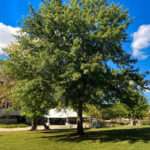 Pin Oak
Pin Oak
Pin oaks are commonly found in North America, from southwestern New England and Midwestern states to Ontario, Canada. Appropriately called a swamp oak, this species enjoys wet riparian environments and tolerates poorly … | Learn More
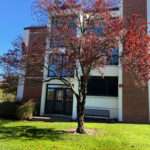 Purple Leaf Plum
Purple Leaf Plum
Like many ornamental plants, the purple leaf plum is not native to the United States. They originate from western Asia and were brought to southeastern Europe in the 1800s. Their close relative, the garden plum, Prunus domestica, …| Learn More
 Red Maple
Red Maple
Red maple, or Acer rubrum, is similar to the sugar maple, which is often associated with maple syrup, but there are key differences, from the sugar content in each tree’s sap (the sugar maple’s is greater) to the shape of the tree’s leaves. …| Learn More
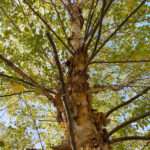 River Birch
River Birch
This beautiful species of tree belongs to the family Betulaceae which also includes five other groups of deciduous nut bearing trees and shrubs. If you encounter this tree in its natural habitat you will notice that, river birches enjoy …| Learn More
 Saucer Magnolia
Saucer Magnolia
Saucer magnolia, Magnolia x soulangeana, is an angiosperm, or flowering plant, in the Magnoliaceae Family. It is a hybrid of two Asian magnolia species, Yulan and Lily, which were crossed to produce a new garden ornamental ... | Learn More
 Southern Magnolia
Southern Magnolia
The southern magnolia, Magnolia grandiflora, is native from eastern North Carolina to the southern half of Georgia and southeast Texas. While Rowan University’s campus is not necessarily the ideal environment for the southern magnolia ... | Learn More
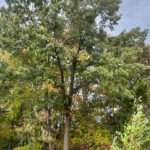 Southern Red Oak
Southern Red Oak
This species is thought to have evolved some 56 million years ago and is native to the United States. You can find them growing anywhere from New Jersey down to Florida and over west to Texas. The southern red oak is also called ... | Learn More
 Star Magnolia
Star Magnolia
Star Magnolia can either be grown as a large shrub or pruned into a small tree, like the tree featured here. A healthy Star Magnolia will grow 15-20 feet tall with a canopy ranging between 10-15 feet, which makes them ideal … | Learn More
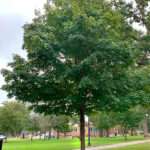 Sugar Maple
Sugar Maple
The scientific name of the sugar maple tree is Acer saccharum. “Saccharum” is Latin for “sugar.” The sugar maple tree is known for the use of its sap , which is used to produce maple syrup. It takes 40 gallons of sap to make … | Learn More
 Sweetgum
Sweetgum
Sweetgum, named for the resinous sap that early American pioneers and Native Americans chewed like gum, goes by the scientific name Liquidambar styraciflua, which translates to liquid amber and “flowing with resin”… | Learn More
 Sweetbay Magnolia
Sweetbay Magnolia
The beautiful Sweetbay magnolia is derived from the ancient family Magnoliaceae. It is native to North America and adapted over millions of years to the acidic soil and seasonal variations of the coastal plains. Historically important … | Learn More
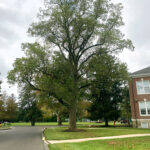 Tulip Tree
Tulip Tree
The species is commonly known as the tulip tree due to the cup-shaped, tulip-like flowers that it produces in late spring. If you are visiting this tree between April and June, you might be able to spot the flowers in the canopy or … | Learn More
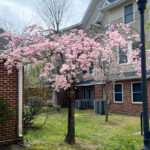 Weeping Higan Cherry
Weeping Higan Cherry
The Weeping Cherry is a deciduous tree, which means that it loses its leaves as the seasons change. In the spring and summer, the leaves are a bright green, and then they turn yellow in the fall before they drop in preparation … | Learn More
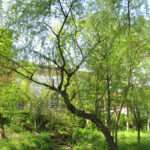 Weeping Willow
Weeping Willow
The weeping willow tree is characterized by its silver colored bark. The wood from this tree also tends to be rather fragile compared to other trees. This tree does not grow very tall, instead maxing out between 30 and 50 feet … | Learn More
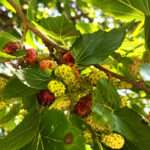 White Mulberry
White Mulberry
White mulberry trees, also known as silkworm mulberries, are native to Northern China, where they are used for producing silk. They were introduced into Europe in the 1500’s before being brought to the United States … | Learn More
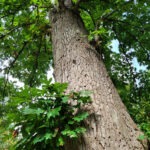 White Oak
White Oak
White oaks are known to be one of the major oak species that reside in a majority of the hardwood forests of Eastern and Southern North America. White oak trees are tall, sometimes growing up to eighty to one hundred feet … | Learn More
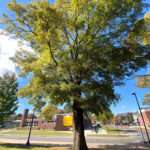 Willow Oak
Willow Oak
The willow oak can grow up to 40-75 feet tall and 25-50 feet wide. Their large size can make them susceptible to wind damage. Willow oaks tolerate urban pollution, and can survive in any type of soil, including clay. The willow oak has … | Learn More
Resources About Trees
Books
-
- Trees of Eastern Northern America written by Gil Nelson, Christopher J. Earle, Richard Spellenberg, Amy K. Hughes, and David More
- Trees of Western North America by Richard Spellenberg
- Trees of Pennsylvania, the Atlantic States, and the Lake States written by Hui-Lin Li
- The Illustrated Encyclopedia of Trees written by David More and John White
- The Sibley Guide to Trees written by David Allen Sibley
- Trees: An Illustrated Identifier and Encyclopedia written by Tony Russell and Catherine Cutler
For more books on trees visit the Resources About Trees page!
Journals
You may need to log in with Rowan University credentials to view these items
Journal Articles
-
- Li L, Yu Z, Bebout GE, Stretton T, Allen A, Passaris P. (2010). Tree-ring width and δC records of industrial stress and recovery in Pennsylvania and New Jersey forests: Implications for CO2 uptake by temperate forests. Chemical geology. | Link (Rowan Login Require)
- Geng Y, Dighton J, Gray D. (2012). The effects of thinning and soil disturbance on enzyme activities under pitch pine soil in New Jersey Pinelands. Applied soil ecology : a section of Agriculture, ecosystems & environment. | Link (Rowan Login Require)
